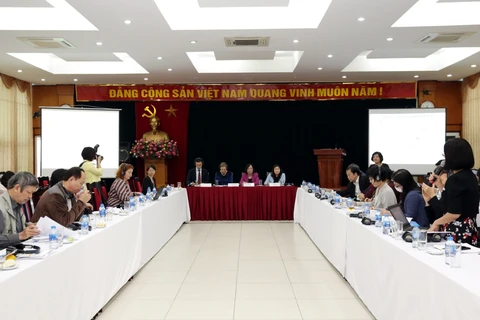 A doctor gives medical check-up to local people in northern mountainous province of Cao Bang (Photo: VietnamPlus)
A doctor gives medical check-up to local people in northern mountainous province of Cao Bang (Photo: VietnamPlus)
Hanoi (VNA) – A host of problems relating to population quality, structure, and distribution has raised concerns in the meantime.
“At present, a man in Vietnam has an average longevity of 72.1 years old, while a woman enjoys 82.3 years old. Accordingly, life span in the country averages 76.6 years old, which is higher than the world’s average. However, the quality of our older generation is facing some problems.
According to the World Health Organization in Vietnam, each old person in Vietnam deals with three types of diseases. It shows while the people’s life expectancy is longer, the number of their quality living years is shorter.”
These remarks were made by Bui Sy Loi, Vice Chairman of the National Assembly’s Committee for Social Affairs at an online talk on “Population and development: New opportunities and challenges” organized by the General Department for Population and Family Planning in conjunction with the Dai Bieu Nhan Dan (People’s Representatives Newspaper) in Hanoi on June 13.
Speaking about population achievements over the past time, Loi said the population and family planning work has over the past decade ensured total fertility rate of 2.1 children per woman (Replacement-level fertility). The work has assured that the country has had a proper population structure, providing a workforce that satisfied market requirements for national growth while reducing unemployment rate during the Doi Moi (renewal) period.
“The positive population and family planning work over the past ten years has been attributed to the right policies issued by the Party and State, the involvement of the entire political system, and the contingent of experienced population and family planning workers. Over the decade, the replacement-level fertility has been safeguarded, marking an important attainment that reflected the viewpoints of the Party and State as well as the effective response of the Government, ministries, sectors and localities,” Loi said.

Bui Sy Loi, Vice Chairman of the National Assembly’s Committee for Social Affairs (Photo: VietnamPlus)
However, at the moment, problems appeared, Loi said, pointing to the quality, structure, and distribution of population in regions, and in ethnic minority groups inhabiting in mountainous and remote areas in comparison with urban areas and other localities.
These problems require the Party and State to make a shift in policy, he stressed, stressing that Resolution 21 NQ/TW 2017 on population work in the new periods requires the population and family planning work to shift the focus of population and family planning to development and population.
According to Bui Sy Loi, the population work change will prepare for the process when “the golden Vietnamese population structure” is replaced by aging population.
Resolution 21-NQ/TW 2017 says the population structure shift is aimed to meet new requirements on population development, helping to provide a quality workforce to supply for the labor market and meet the needs of industrialization and modernization and the fourth Revolution.
There are three challenges in the population work, including expanding fertility levels between areas and regions, gender imbalance at birth, and the adaptation to aging population.
Bui Ngoc Chuong, Vice Chairman of the National Assembly’s Committee for Social Affairs said the three challenges have been recognized long ago but solutions to them remain absent, so they are still pressing issues that need to be addressed.
He spoke about problems relating to culture, psycho, and national tradition, as well as differences in fertility rates among regions and areas, raising the fact that the fertility rate is low in big urban areas like Ho Chi Minh City and the southeastern part, while it is high in underdeveloped areas.
Gender imbalance stemmed from gender discrimination and the root cause of son preference. The situation has seen some improvements owing to the implementation of gender policies and responding measures, but remains far from expectations. Through monitoring, Hai Duong and Hung Yen provinces, which have high living conditions, were found to struggle against high gender imbalance and high birth rate.
Chuong said aging population is the most visible challenge that needs to be tackled, and pointed to the necessity to devise policies for 21 million old people towards optimizing their brainpower and ensuring they have a stable and quality life.
The talk aimed to pool opinions from National Assembly deputies, experts, managers, and voters on achievements of the population work and figure out weaknesses and solutions to arising problems.-VNA
| On October 25, 2017, Party General Secretary Nguyen Phu Trong signed to issue Resolution 21-NQ/TW of the 12th Party Central Committee’s sixth session on population work in the new situation. It is the first time in 25 years that the Party Central Committee commented that if birth control policy has been maintained for too long, it could be hard to address its implications. |























